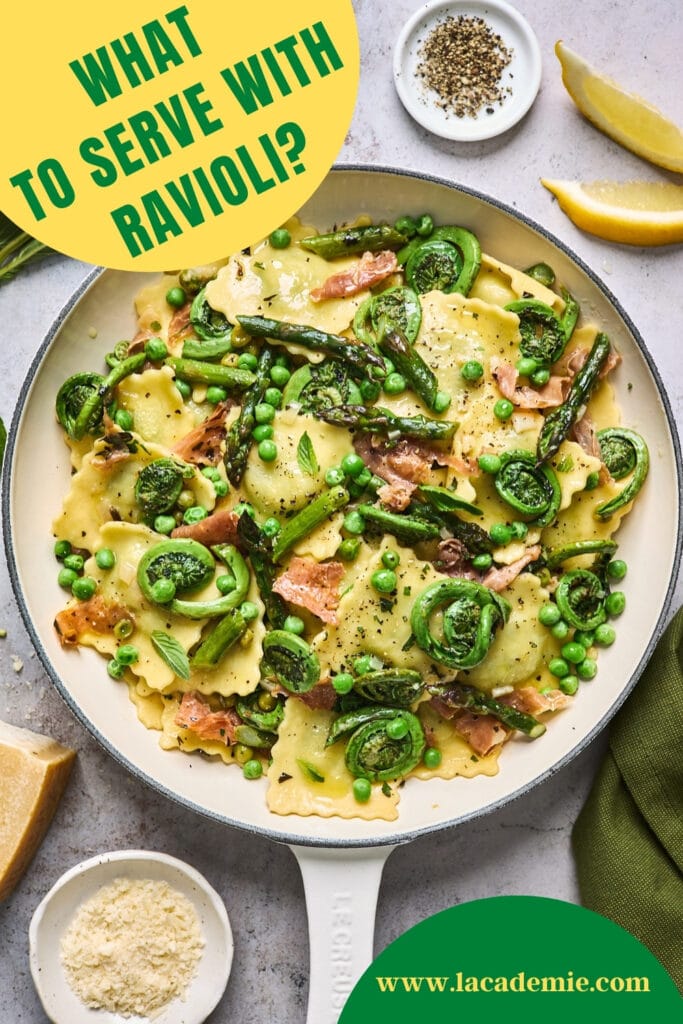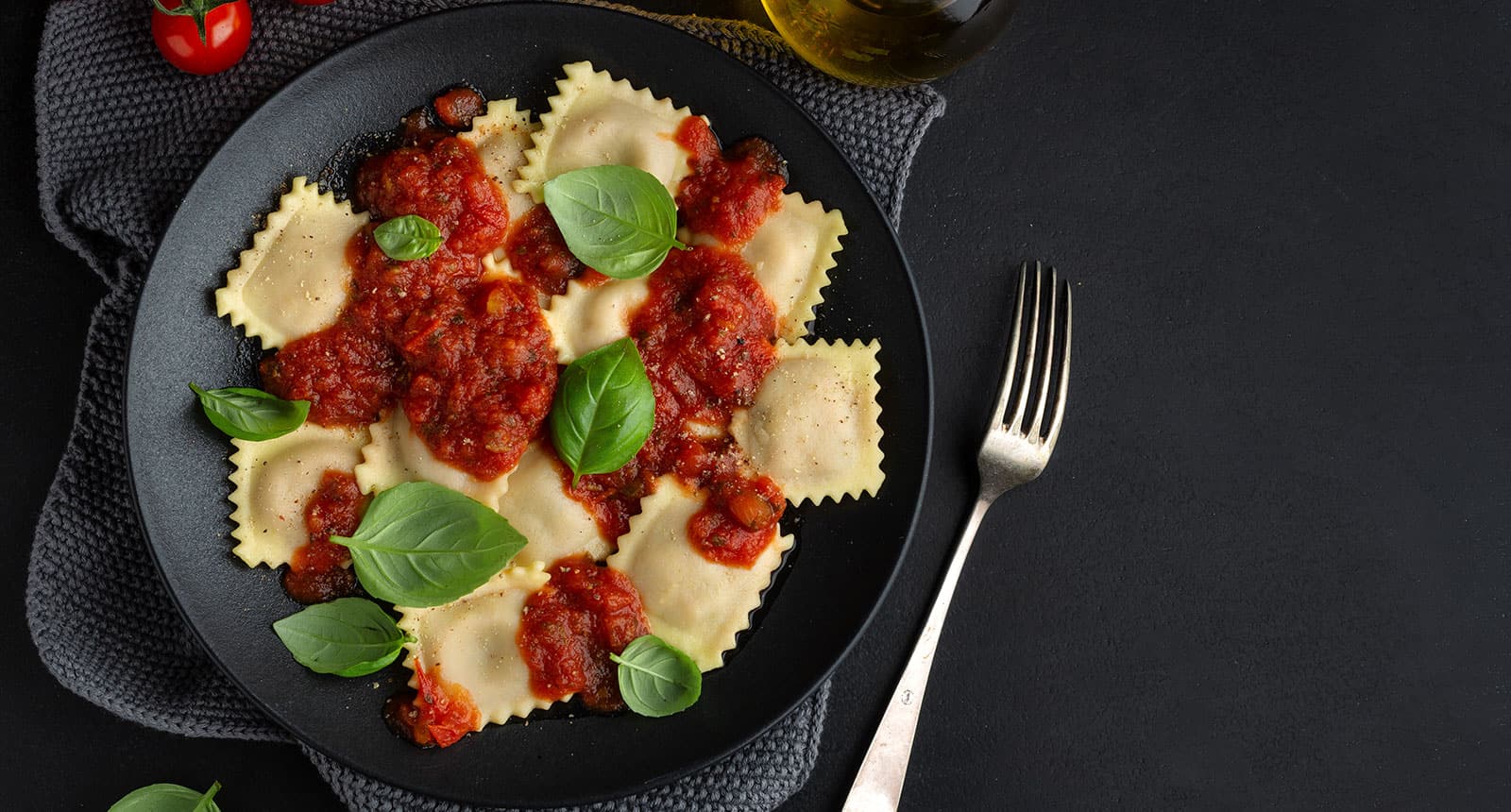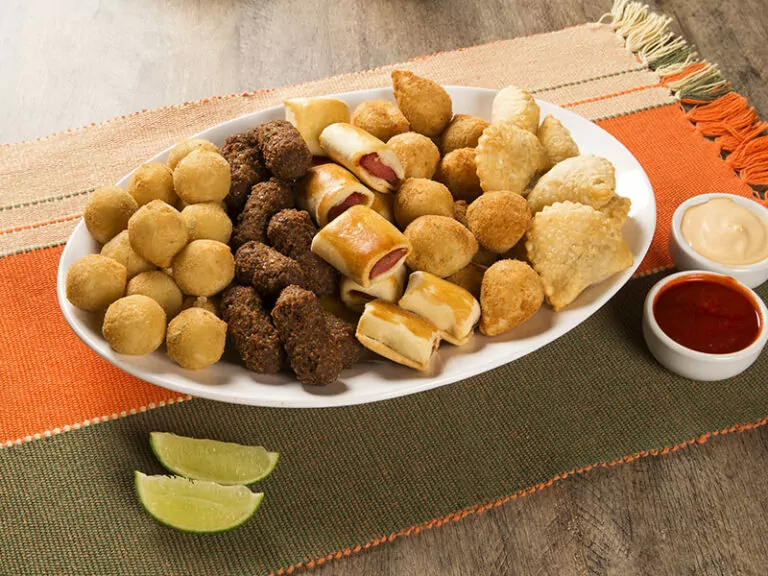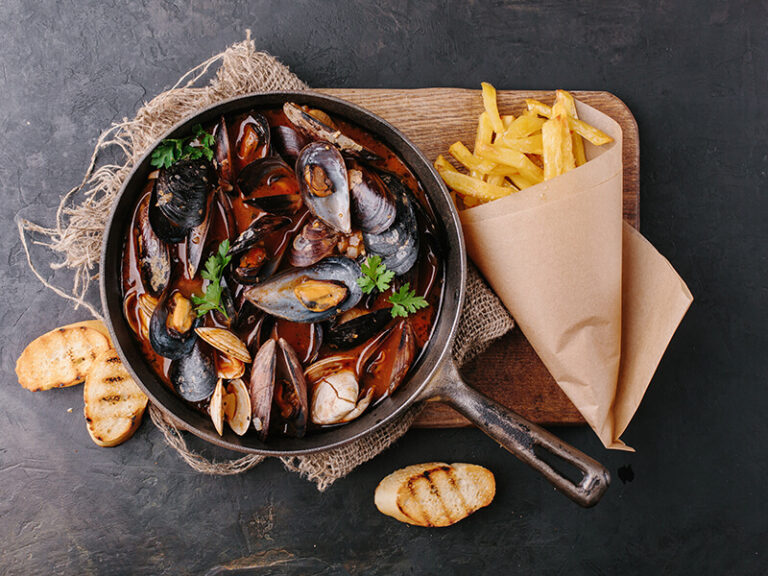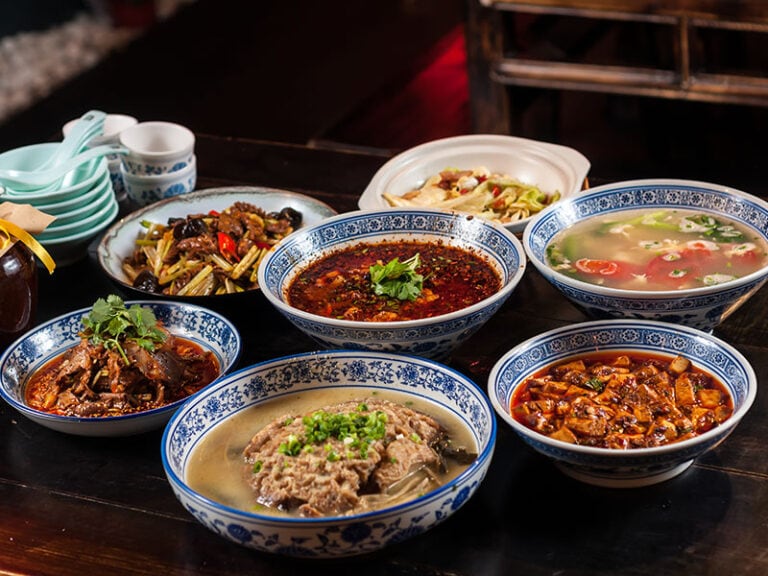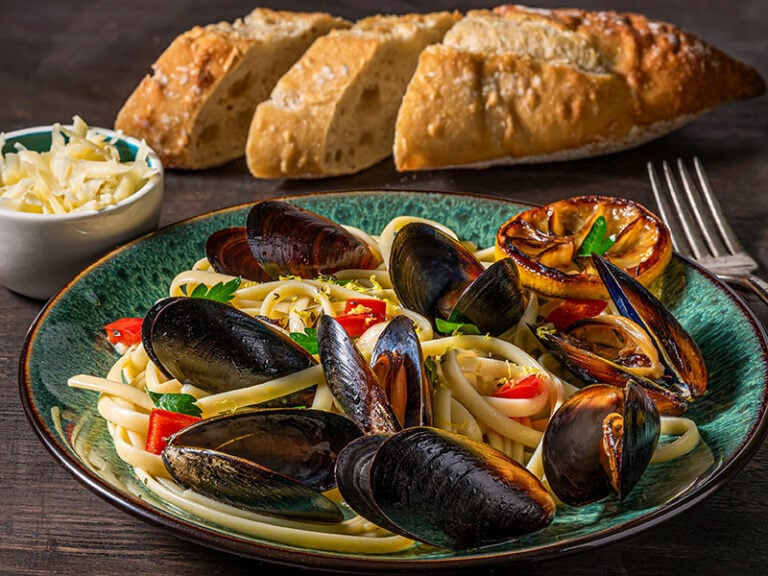What to serve with Ravioli, the ultimate godsend pasta? It is classified as one of the most famous traditional pasta dishes in Italy. Absolutely no dish can compete with the deliciousness, richness, and taste of this pasta.
However, you sometimes feel dissatisfied when eating your Ravioli. You feel something is lacking and want to enjoy some better flavor than that! Just the flour, and the filling, and the source cannot make you so happy as you should!
Yes, then I’m here to solve your problem. Because you know, what’s really special about Ravioli is that you can enhance its flavor with a variety of delightful side dishes!
Therefore, why not let me help you? Join me to learn about Ravioli and its side dishes quickly. You can’t help but know about it!
What To Serve With Ravioli?
Today, I present to you 13 of the best side dishes to make your Ravioli even better:
- Roasted Vegetables
- Spring Salad
- Caesar Salad
- Broccoli Rabe
- Cipollini Onions
- Asparagus Wrapped in Prosciutto
- Green Beans
- Snap Peas
- Zucchini Crisps
- Italian Bread
- Garlic Bread
- No-knead Sourdough Rolls
- Polenta
What Is Ravioli?
Unlike other long, flat spaghetti or other shapes like Ziti and Penne, this food whose name begins with “R” is quite different because it is a type of pasta with filling inside ( cheese, meat, vegetables, etc.).
It has a shell made of flour, eggs, and milk. This dish is served with sauces such as cream sauce, ketchup, cheese sauce, etc. In addition, the shape of the Ravioli is also quite diverse. The most common are squares with jagged edges, circles, rectangles, triangles, etc.
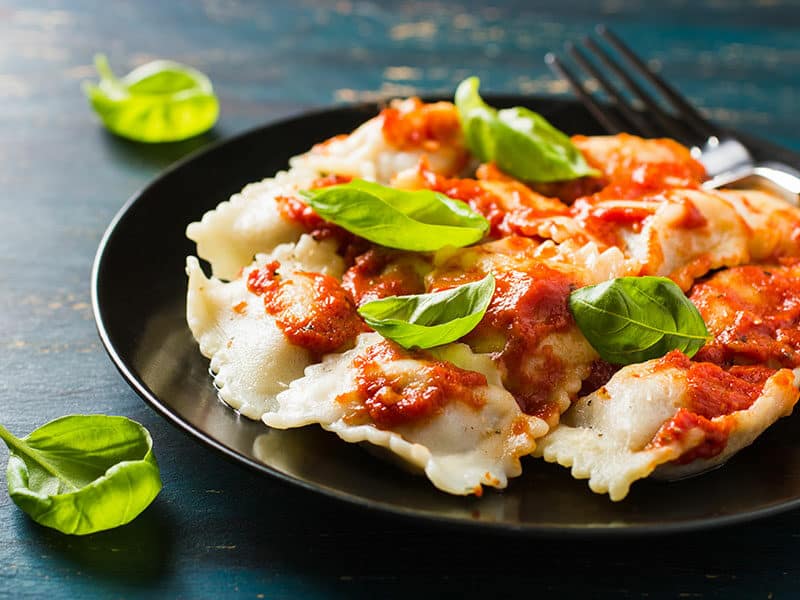
To imagine a simple way, Ravioli is like a type of pasta with filling, with the shell made from flour, eggs, milk, rolled into two layers, wrapped around the core, and then folded with the eyelids to stick.
The filling of this dish depends on the taste of each locality, so it is equally rich. It may include chorizo sausage, minced beef, shrimp meat, crab, spinach, ricotta, nutmeg, black pepper, etc.
The simplest and most popular way of cooking is to boil the Ravioli in a superior pasta pot and serve it with aromatic pasta sauces, add a little shredded cheese, spot a few greens and fresh basil leaves. Only that, but it is already delicious, irresistible, and attractive.
This dish can be used with the most familiar sauces for pasta, such as tomato sauce, cream sauce, cheese sauce, etc. Not only enjoyed with sauce, Ravioli is also grilled or deep-fried, making it a very interesting appetizer or snack.
The Origin Of Ravioli
Ravioli is native to Italy and is mentioned in Prato’s personal letter in the 14th century.
At that time, in Venetian cuisine, Ravioli was made from herbs, pureed and mixed with eggs and fresh cheese. Then, it is simmered in broth and seasoned before serving.
However, in Rome, the famous chef Bartolomeo Scappi served Ravioli and boiled chicken during a papal convention in 1549.
During the 14th century, Ravioli also appeared in England when it came to the Forme of Cury recipe collection. Maltese Ravioli, for example, is stuffed with Ricotta sheep milk cheese.
It can be seen that Ravioli appeared for a long time in Italy in the 14th century, and each region will have a different way of processing Ravioli.
Ravioli In Cultures Around The World
Traditional Ravioli can be considered an element for traditional soups originated from Italy. It’s often filled with ricotta cheese, spinach, nutmeg, and black pepper. Also, Ravioli in Sardinia is filled with ricotta and grated lime peels.
In Cyprus, Ravioli will be filled with Halloumi, a hard cheese soaked in saltwater and made from goat and sheep milk, boiled in chicken broth served with grated flour and dried mint.
In Turkey, manti is a traditional dumpling filled with lamb or ground beef similar to Ravioli served with chili sauce and yogurt. It’s also an essential dish of Kazakhstan, Kyrgyzstan, and Turkic cuisines.
East Asian countries such as Korea, China, and Japan have similar dishes to Ravioli as jiaozi, baozi, and wonton.
Gujiya is a dish similar to Ravioli in India with a filling of dried fruit, sugar, and a mixture of sweet spices deep fried in vegetable oil. This dish is often processed during festivals.
The food culture of Palestine, Israel, and other Middle Eastern countries have a shish Barak dish similar to Ravioli that is filled with minced beef and cooked in hot yogurt.
In Jewish cuisine, the kreplach with an egg pasta topped with the meat simmered in a chicken soup is said to be the inspiration of Ravioli.
Ravioli Filling: The Deciding Factor For Choosing Side Dish
In fact, Ravioli requires finesse and specificity when you choose the dish that goes with it. That is directly related to the Ravioli’s core. That means you must choose sauces and side dishes that match the type of your Ravioli filling.
Ravioli has several popular fillings such as Avocado Avocado, Crab Ravioli, or Lobster Ravioli, a richly salty minced meat filling and even mushroom Ravioli, or a lighter ricotta spinach filling. Often the rule prefers a combination: rich and savory with sweet and fatty, and vice versa.
What To Serve With Ravioli: 13 Best Side Dishes You Must Know
As mentioned above, each of your personal Ravioli filling preferences will bring you different suitable side dishes to balance the flavor. Here I will give you the most concrete examples:
1. Roasted Vegetables
It sounds simple enough, but roasted vegetables can be eaten with a bunch of delicious dishes. Likewise, it also gives a rustic and sweet flavor to your Ravioli. More specifically, if you are making dilute Ravioli with ketchup or braised chicken, then the roasted vegetable is great to go with.
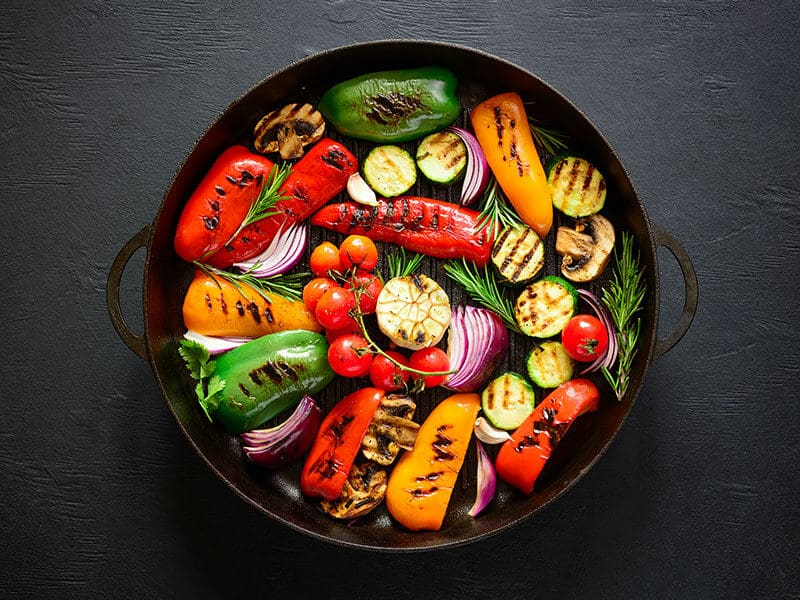
The vegetables that you can consider roasted are root crops. You can use sweet potatoes, carrots, beets, or whatever you like. These vegetables, once roasted, will have a natural sweet taste to add to your Ravioli.
Furthermore, roasting them is also an effortless job. Just make sure to cut vegetables into evenly sized portions by using your familiar vegetable chopper. In that way, they will cook evenly. Then, you use olive oil, salt, and pepper to cover the cut vegetables.
Next, you just need to bake it all in your oven. And remember not to put too many pieces on one baking tray since each piece has a little space. When you see the yellow and have some scorch marks, it’s time to bring them out.
Nutrition Facts per Serving (1 Cup):
- Calories: 162
- Carbohydrates: 28 g
- Fiber: 5 g
- Protein: 3 g
- Fat: 5 g
- Sodium: 426 mg
2. Spring Salad
If you still haven’t found a suitable side dish for Ravioli, why not try a spring salad? You can add some greens, herbs, blanched asparagus, and nuts to make your spring salad creative, crunchy, and flavorful.
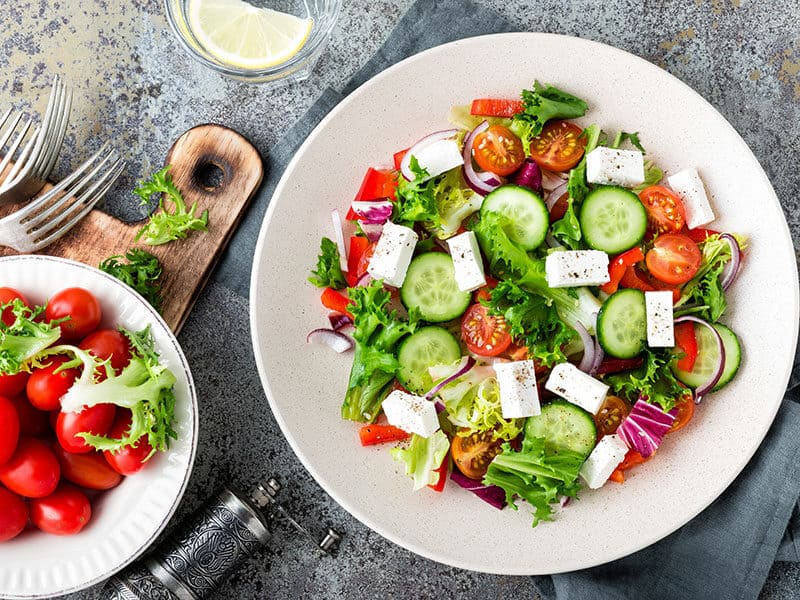
The best thing about spring salads is that no matter what kind of Ravioli you have, it will come right. Whether it’s lobster ravioli, pumpkin, or cheese, spinach, and ricotta, whatever Ravioli you like will be great on a spring salad.
Nutrition Facts per Serving (3 Oz):
- Calories: 20
- Carbohydrate: 3g
- Fiber: 1g
- Protein: 2g
- Fat: 0g
- Sodium: 4%
3. Caesar Salad
When you don’t have too much time to prepare side dishes, choose a caesar salad as the simplest one to eat with your Ravioli. This food starting with C only requires easy-to-find ingredients that are available in most kitchens and a few minutes to prepare.
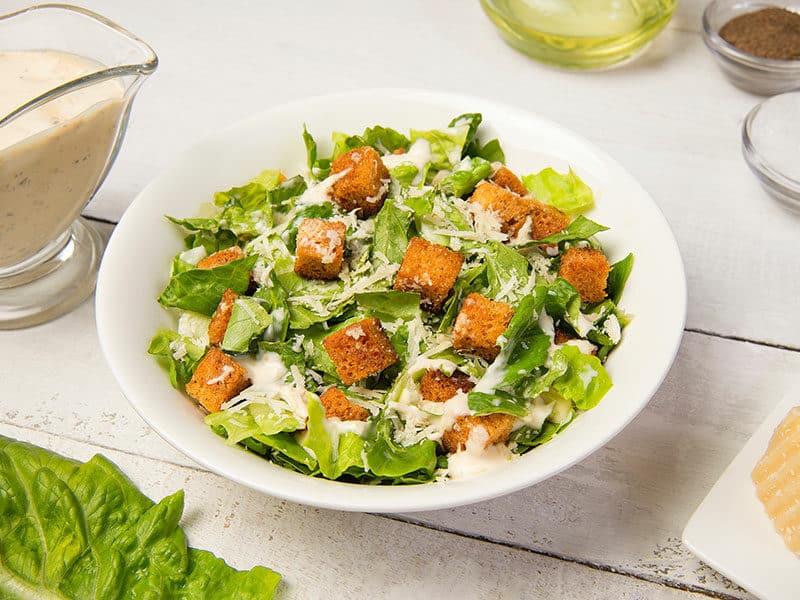
You only need a few minutes to blanch lettuce and croutons over boiling water and let it drain. Some may confuse lettuce with cabbage. So, you’d better be careful when choosing.
Then, to make the sauce, a few minced garlic cloves combined with mayo and a few tablespoons of your favorite sauce are enough to make your Caesar salad taste great.
You can add some lemon juice, cheese, and mustard if you want more flavor. Pureed black pepper and salt are also indispensable ingredients. Then, just put it in the fridge and go to your work.
When you want to eat, blend this sauce with your spinach. You can also add cheese bread. Caesar salad is quick to make and suits almost any type of Ravioli.
Nutrition Facts per Serving (1/4 Cup):
- Calories: 41
- Carbohydrate: 2 g
- Fiber: 0g
- Protein: 2 g
- Fat: 3 g
- Sodium: 265 mg
4. Broccoli Rabe
The buttery pumpkin ravioli taste is relatively sweet and light, so I recommend pairing it with a side dish that is richer and more savory. So, pumpkin avocado Ravioli is especially significant with broccoli rabe. This is a vegetable that is relatively similar to broccoli.
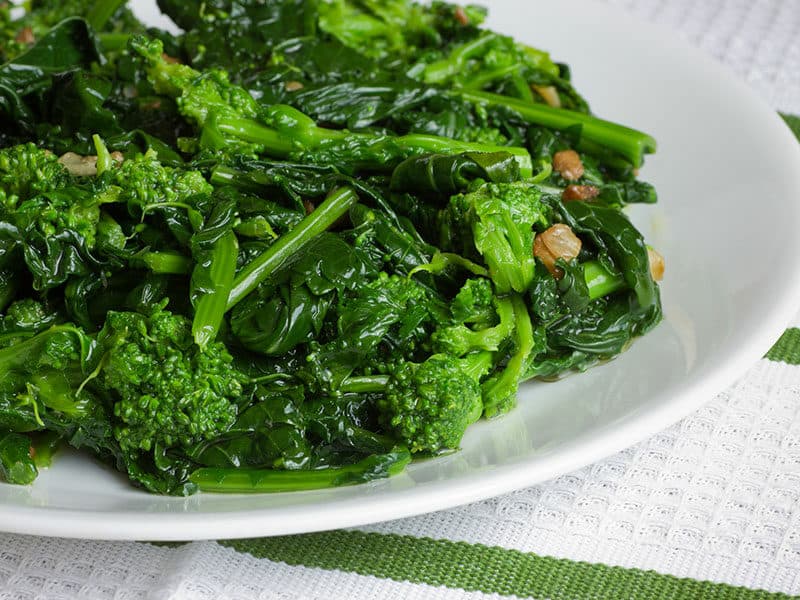
You can make use of its stems, leaves, and buds. So get your broccoli rabe ready to eat with your Ravioli. You can thoroughly combine them with roasted chili and tomato, coated in romesco sauce to perfectly match all the great fusion flavors.
Nutrition Facts per Serving (1 Cooked Bunch):
- Calories: 144.2
- Carbs: 13.6 g
- Fiber: 12.2 g
- Protein: 16.7 g
- Fat: 2.3 g
- Sodium: 244.6 mg
5. Cipollini Onions
If you didn’t know, Cipollini onions are smaller and lighter versions of regular onions, so they look pretty. They are a great candidate for roasting as they have a sweeter taste.
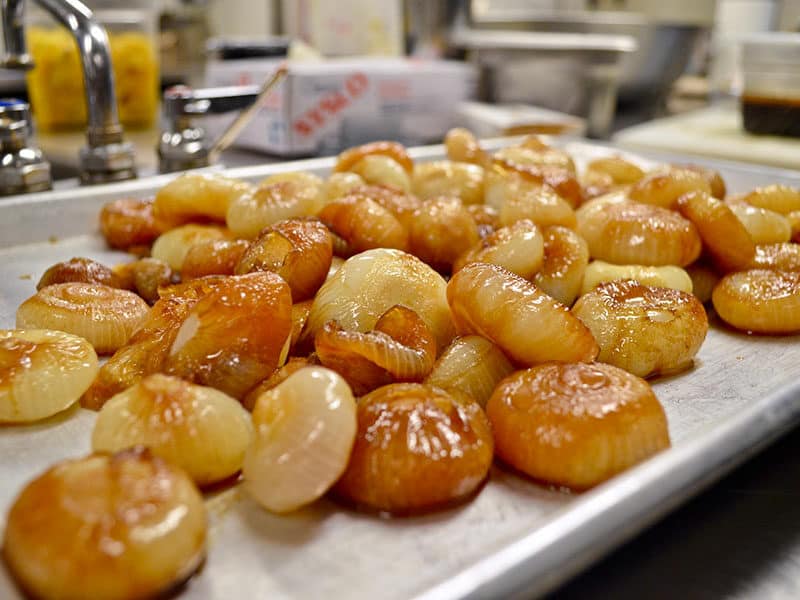
The truth is they can become caramel and soft when you take the time to roast them in butter or balsamic vinegar. Unlike other onions, cipollini onions, when roasted, will not emit any unpleasant pungent flavor but rather a pleasantly sweet aroma.
Cipollini onions can make any dish burst with great taste. When pairing with your favorite Ravioli, the cipollini gives a sweet and savory taste that you will definitely never forget.
Nutrition Facts per Serving (80g):
- Calories: 35
- Carbs: 8 g
- Fiber: 2.8 g
- Protein: 1g
- Fat: 0
- Sodium: 0
6. Asparagus (Prosciutto Wrapped)
If you have a sweet cheese-filled Ravioli, you will need crisp and savory Ravioli side dishes for added flavor. Yes, steamed asparagus can be perfect, but rolled asparagus with a hint of Prosciutto would be irreplaceable.
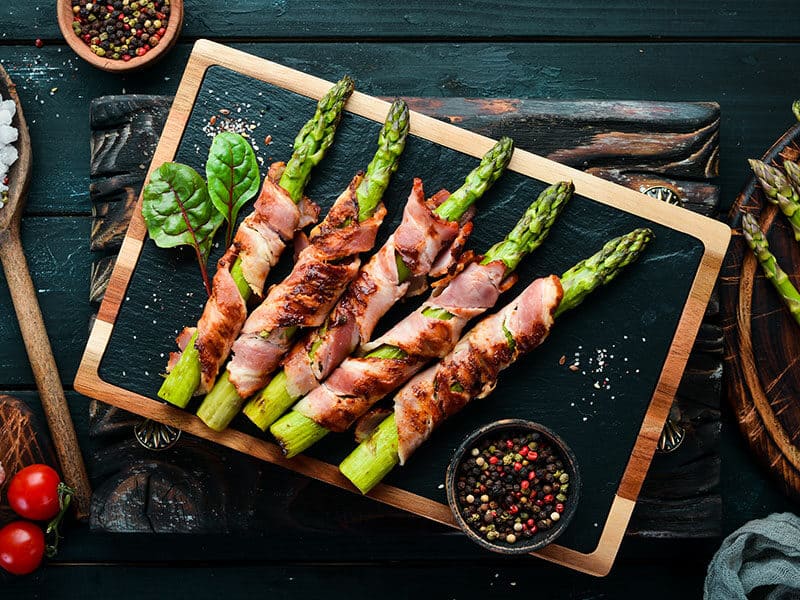
I think this is the perfect side dish for Ravioli with decadent and rich filling. It provides a moderate salinity of Prosciutto, with the signature crunch of asparagus to add a rich flavor to your Ravioli.
Nutrition Facts per 1 Serving:
- Calories: 56.2
- Carbs: 2.7 g
- Fiber: 1 g
- Protein: 3.9 g
- Fat: 3.7 g
- Sodium: 367.6 mg
7. Green Beans
Crispy and light green beans are incredibly good for your health. And they also go well with almost any dish you want. And of course, including your favorite cheese-filled Ravioli.
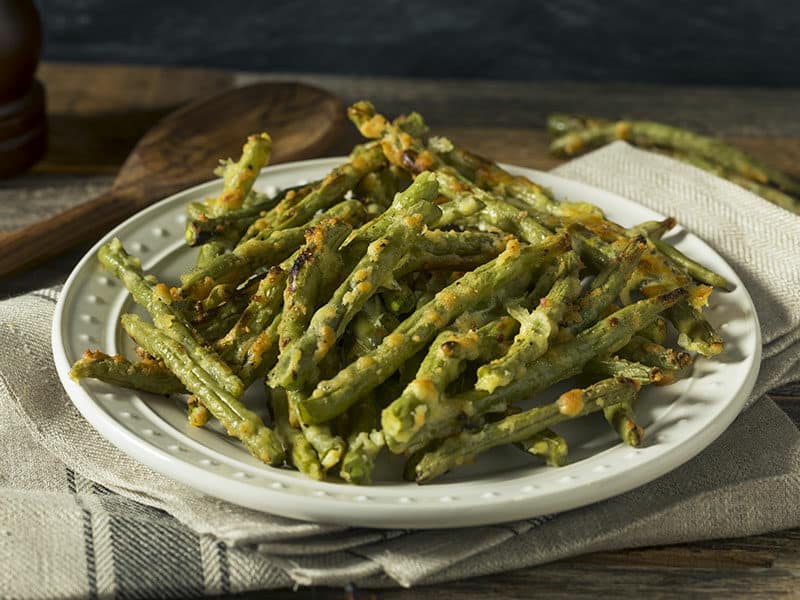
Just combine green beans with a little freshly ground garlic parmesan to increase their taste. Green beans covered with garlic parmesan combined with the sauce will form a wonderful melt in your mouth.
Nutrition Facts per Serving (150 G):
- Calories: 28
- Carbs: 5.66 g
- Fiber: 2.6 g
- Protein: 1.42 g
- Fat: 0.55 g
- Sodium: 0 g
8. Snap Peas
A great side dish with the lobster Ravioli is nothing more than the snap peas itself. They will make your Ravioli look even brighter and more attractive.
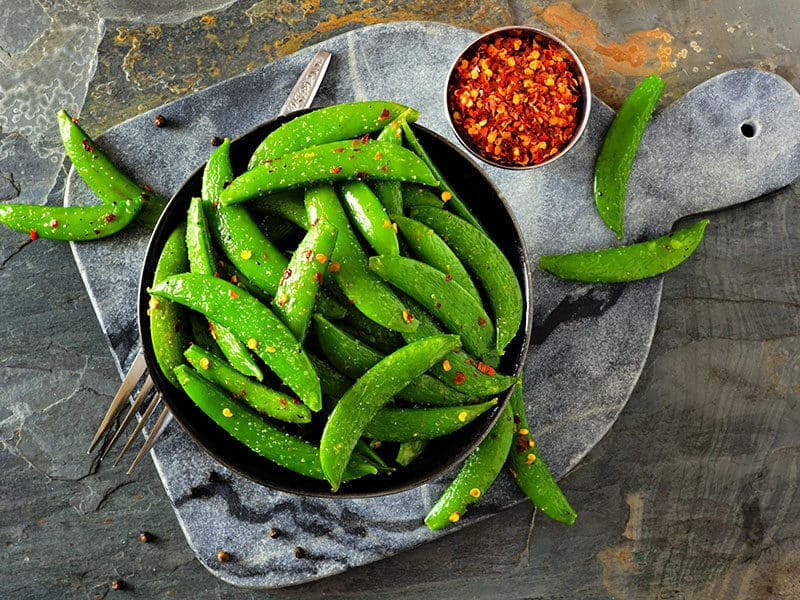
Indeed, peas are the perfect vegetable that not only lets you add more fiber to your Ravioli but also enhances its flavor.
The way to do it is also very simple. You just need to cook a little to be able to turn the peas to brown. Their natural sweetness is then activated and ideally added to your Ravioli.
Nutrition Facts per Serving (¾ Cup):
- Calories: 40
- Carbs: 9 g
- Fiber: 2 g
- Protein: 2 g
- Fat: <1 g
- Sodium: 0 g
9. Zucchini Crisps
Crisps is a dish suitable for almost any dish, including the Ravioli. Some parmesan crisps paired with zucchini are a great finishing recipe. If you didn’t know, it’s a great combination of grilled Parmesan cheese cubes and creamy zucchini slices.
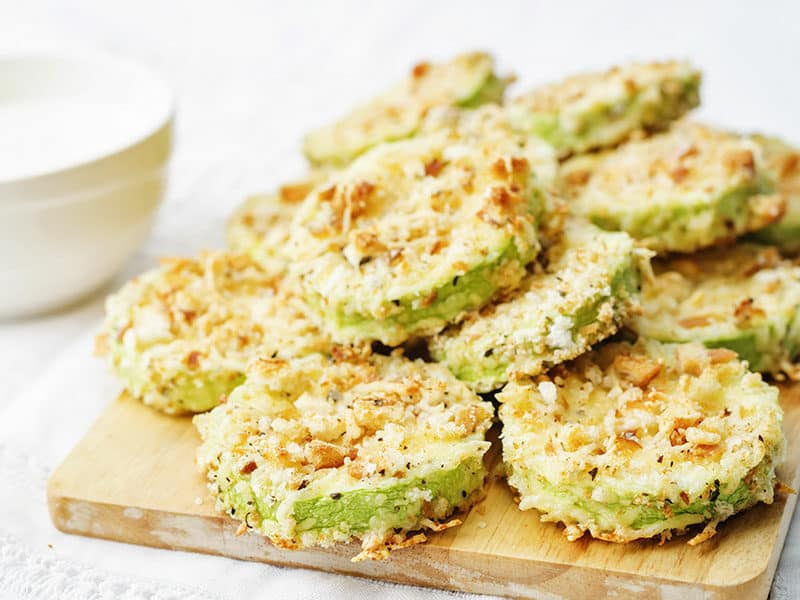
When you combine this light and tasty snack with the Ravioli, you get perfection. It’s a pair that is both soft and crispy, really can never go wrong. And as you know, cheese and Ravioli are always more delicious when combined together.
Nutrition Facts per Serving (4):
- Calories: 15.2
- Carbs: 3.6 g
- Fiber: 1.3 g
- Protein: 0.6 g
- Fat: 0.1 g
- Sodium: 77.3 mg
10. Italian Bread
If you want a full meal with Ravioli, a few slices of this bread is indispensable. This is a perfect side dish that Italy has for you and your meal. What makes Italian bread so great is that it will soak up all your quintessential sauce and melt in your mouth with great taste.
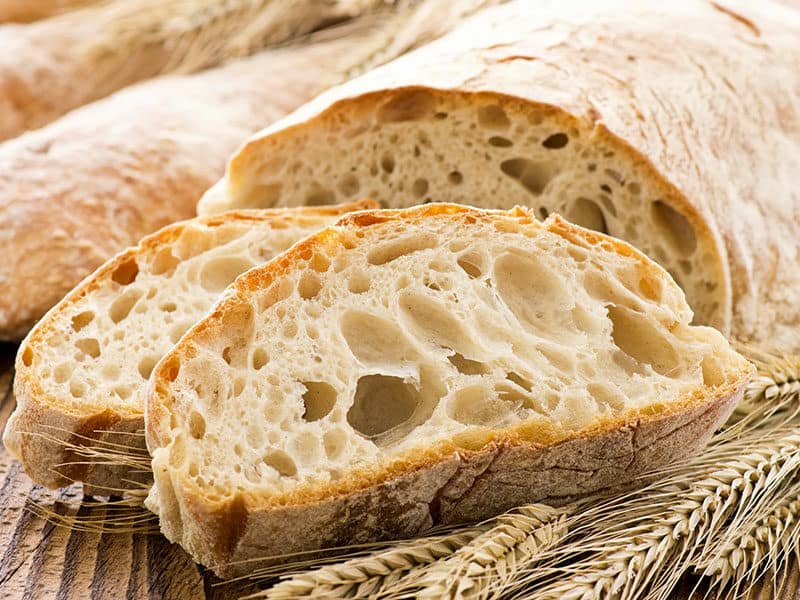
The best part is that your bread is relatively easy to make. You absolutely can make spaghetti with your own hands. You just need some flour, salt, dry yeast, and sugar.
Toast is a more enjoyable job than you might think. What better way than serving spaghetti with Ravioli for dinner!
Nutrition Facts per Serving (¼ Loaf):
- Calories: 200
- Carbs: 36 g
- Fiber: 1 g
- Protein: 8 g
- Fat: 2.5 g
- Sodium: 370 mg
11. Garlic Bread
Yes, I have just mentioned Italian bread, but garlic bread is another category. Traditional garlic bread will also give a great experience when eaten with Ravioli. Plus, you can easily make your own garlic bread by adding it to the oven, and it’ll be ready in just a few minutes.
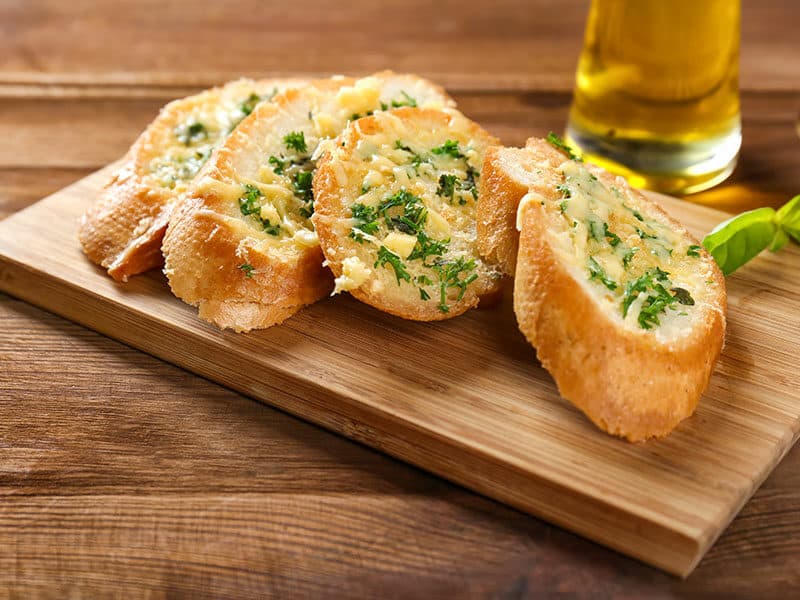
The great thing is that regardless of your sauce and Ravioli filling, garlic bread will also be an excellent addition to them. The wonderful flavors of bread, garlic, cheese, butter, and herbs will soak up and blend in with any sauce.
Nutrition Facts per Serving (1 Piece):
- Calories: 157
- Carbs: 16.8 g
- Fiber: 0.1 g
- Protein: 2.5 g
- Fat: 8.8 g
- Sodium: 69.7 mg
12. Sourdough Rolls (No-Knead)
No-knead sourdough rolls can be distinct but still have their own wonderful flavor and texture. And their distinct flavor will be delicious when combined with Ravioli.
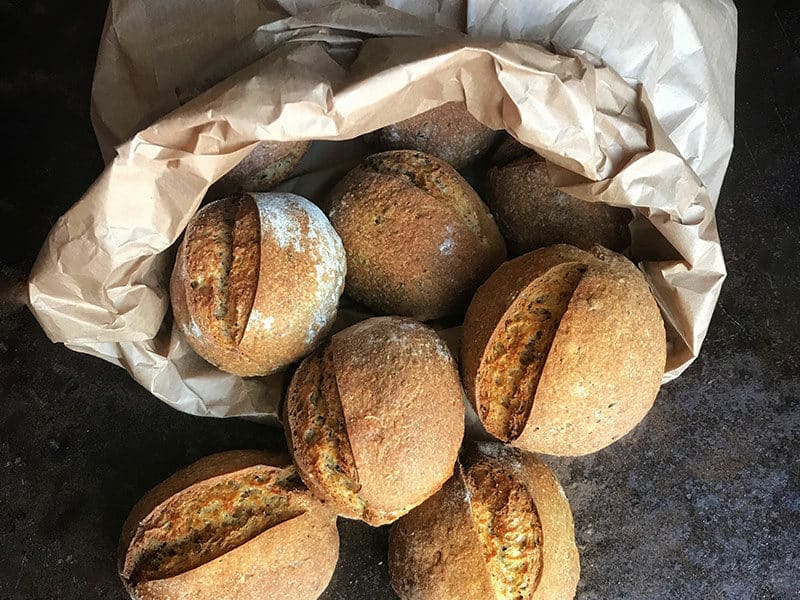
Thanks to their superb absorbent sauce, these small rolls will work well with any of your favorite Ravioli fillings, whether filled with cheese, lobster, tomato, or any other sauce.
With a bit of dipping, the sourdough rolls will absorb the sauce and enhance the ravioli flavor without drowning out its flavor. Also, the other great thing about it is that you don’t have to waste time and effort if you want to make your own because these are no-knead sourdough rolls.
Nutrition Facts per Serving (1 Slice, 78g):
- Calories: 160
- Carbs: 33 g
- Fiber: 0 g
- Protein: 6 g
- Fat: 0.5 g
- Sodium: 440 mg
13. Polenta
You love the lobster-filled Ravioli and want to make it even more appealing? Just pair it with side dishes with a creamy or buttery texture. The best answer is definitely creamy polenta. It couldn’t have a better combination than lobster and polenta.
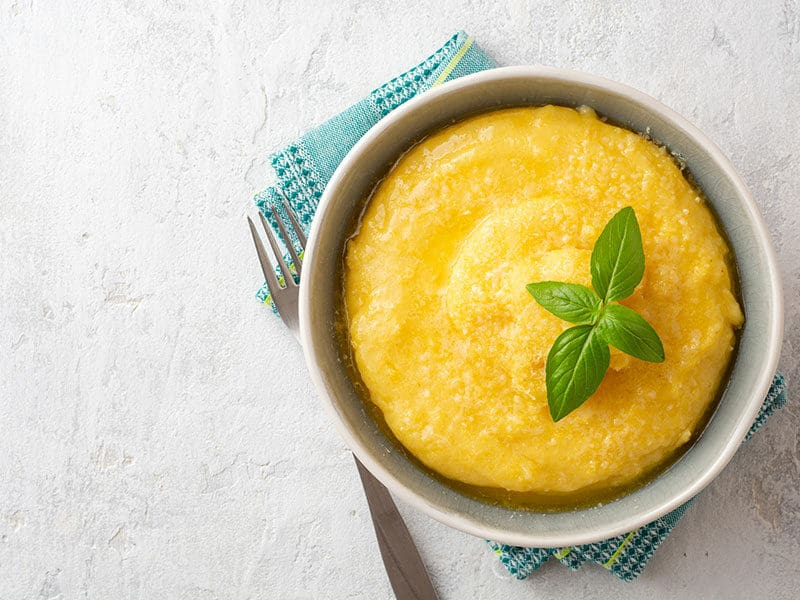
Furthermore, I especially love creamy polenta because it’s so easy to make. Simply put the polenta in a large pot with boiled water and constantly stir to ensure that no clumping occurs.
After 5 minutes of stirring, cover and let low heat for about half an hour. Next, you turn off the heat and add your favorite butter and cheese. Finally, season with salt until you taste it and you have the perfect creamy polenta for your Ravioli.
Nutrition Facts per Serving (¾ Cup):
- Calories: 80
- Carbs: 17 g
- Fiber: 1 g
- Protein: 2 g
- Fat: <1 g
- Sodium: 0 g
How To Make Cheese Filled Ravioli
Today, join me in the kitchen to learn how to make delicious, simple, and standard Italian Ravioli!
Prepare Ingredients (For 2 Servings)
Water 120 ml, Wheat 375 g, Eggs 2, Ricotta Cheese 400 g, Cheddar Cheese 63 g, Parmesan Cheese 50 g, Romano Cheese 50 g, Asiago Cheese 50 g, Olive oil 50 ml, Salt 1/2 teaspoon, Pepper 1/2 teaspoon.
How To Prepare Cheese Filled Ravioli
Step 1: Making The Filling
First, you crushed ricotta cheese in a bowl. Then, add 3 types of cheese (Parmesan, Romano, and Asiago) shredded with Cheddar cheese, 2 eggs, 1/2 teaspoon salt and pepper, and mix until smooth thickened.
Finally, you cover the bowl’s mouth with food wrap and place it in the refrigerator for 30 minutes.
Step 2: Make The Dough
Beat 2 eggs evenly with spices: 1/2 teaspoon salt, 120ml water, and 50ml olive oil. Next, add the prepared flour in a moderate amount, mix until smooth and all the flour is gone.
Tip: Add a moderate amount of flour to the egg mixture, mix well before adding the flour until the end. Avoid giving too much once. It won’t be easy to mix and make the dough smooth.
Step 3: Shaping
For this step, you’d better have an adequate pastry board. It’ll help you shape your Raviola much easier. First, you sprinkle a little flour on the board’s surface, take the dough (done in the previous step), and knead the dough back and forth until it is chewy (about 10 minutes).
Next, use a dough rolling tool to roll the dough so that your dough is about 0.3cm thick. Then, you use a knife to cut the dough to get small square doughs.
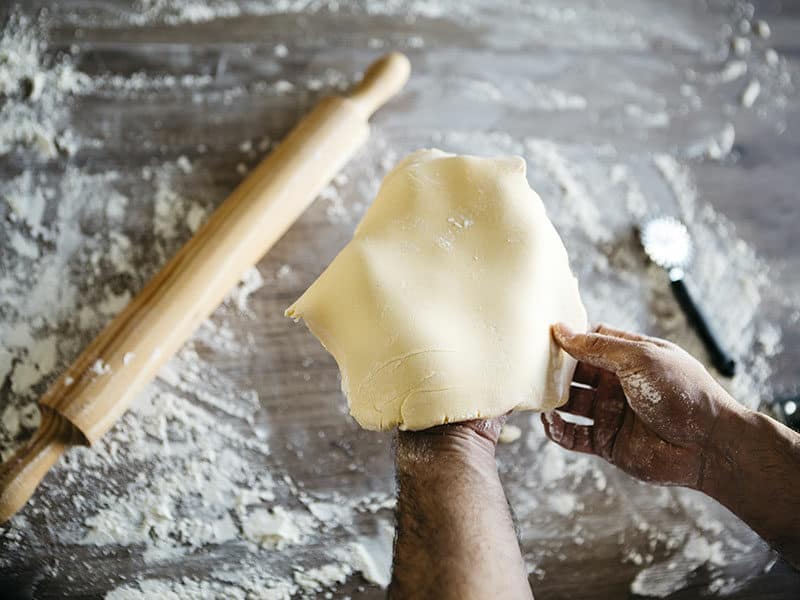
Then, you use a spoon to take the moderate amount of the filling mixture (placed inside the refrigerator cooler) and place it in the middle of the square dough. Using your finger, blot a little water, then apply it to the outside of the rim of the dough, then fold in half, and press lightly to cover the filling.
To create a beautiful border, you can use a fork or a serrated knife to press the edge to appear jagged marks gently.
However, you can also follow the reverse process of having the filling spread evenly over a large piece of dough first, then use a serrated knife to divide it into small pieces of dough.
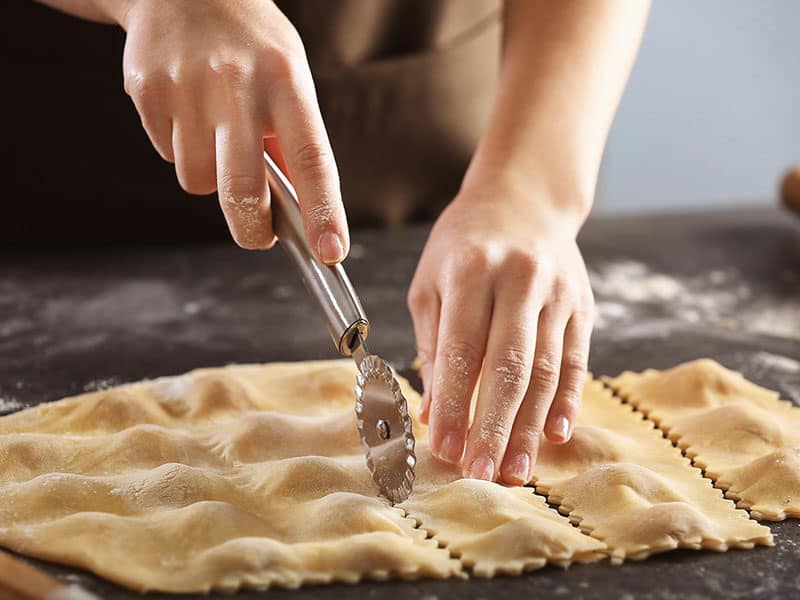
Tips:
- The excess flour can be wrapped in a food container and stored in the freezer for up to 2 weeks.
- Do not roll the dough into two thin pieces because boiling the dough will make the filling fall out. The roll is too thick, it will not taste good, and even the dough is hard to cook.
- Give the filling just right to avoid the Ravioli being blown out when boiled.
- A mold can be used to create more beautiful Ravioli.
Pieces of Ravioli are small, pretty square, filled with the core after being shaped.
Step 4: Boiling
Put the pot of water on the stove to boil, then put the Ravioli, in turn, to boil until the dough emerges – proving that the Ravioli is cooked, picked out for processing according to your preferences.
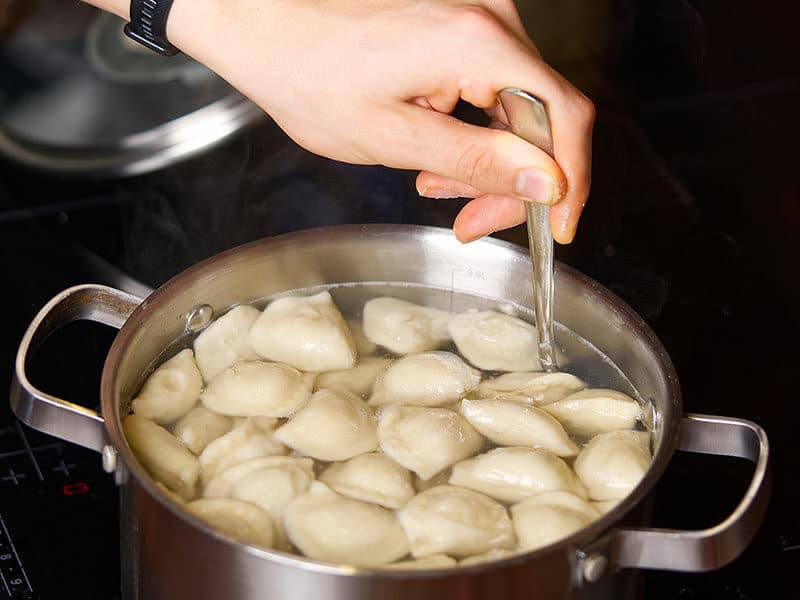
Tips:
- To check whether the Ravioli is ripe or not? You take out and lightly press the edge of the dough to try.
- Avoid boiling the dough for too long because it is easy to break the dough and not to eat it well.
- If you make too many Ravioli, you can store them in the food box, make sure to sprinkle a little more flour between the layers (so the dough won’t stick when used) and place them in the refrigerator cooler.
Finished Ravioli
Ravioli is beautifully shaped and has a golden color thanks to the crust being made of flour. Biting the Ravioli, you will feel the greasy and delicious taste of the many kinds of cheese used. You can enjoy Ravioli with your favorite sauces, such as ketchup or cream sauce.
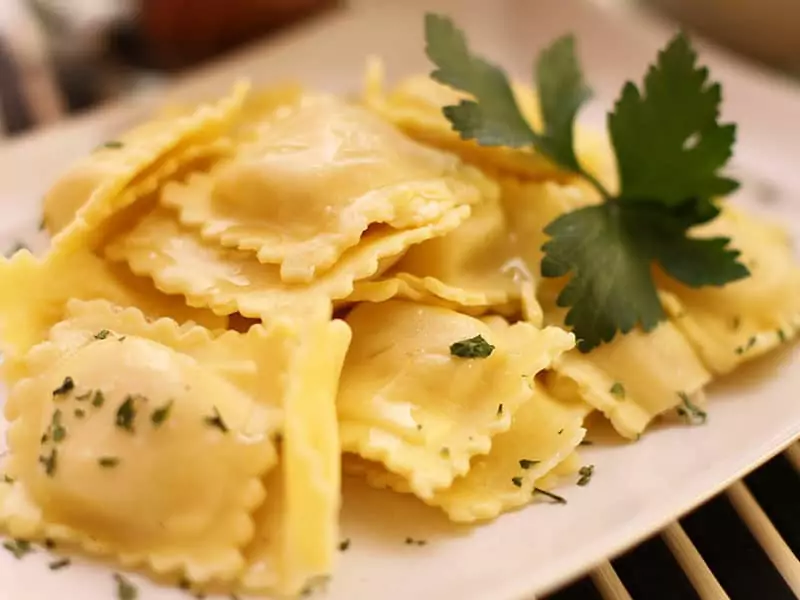
Tips For Making Ravioli Successfully
- Avoid rolling dough because it is too thin because it quickly causes the filling and dough to crumble when boiled.
- It is recommended to coat the dough, surface, and dough slightly with flour during the rolling process to avoid sticking.
- Should put the filling inside the dough with a moderate amount to avoid causing the filling to fall off during processing.
- You can use a mold to shape the Ravioli more beautiful and eye-catching.
- Avoid boiling for too long, making it easy to break or break the shell before enjoying it.
Now, Let’s Choose Your Best Ravioli Side Dish!
Yes, your job now is to choose one and go! I firmly believe that all the side dishes I mentioned above will perfectly match your Ravioli with their own distinctive flavor and texture.
Yes, those are all ideas I can think of to accompany Ravioli, but creativity is unlimited! If you have a great side dish of your own, why not share it with me in the comments?
Nutrition Facts
4 servings per container
- Amount Per ServingCalories369
- % Daily Value *
- Total Fat
26.5g
40%
- Saturated Fat 7.8g 35%
- Cholesterol 25mg 9%
- Sodium 853mg 36%
- Potassium 435mg 13%
- Total Carbohydrate
21.2g
8%
- Dietary Fiber 0.8g 0%
- Sugars 3.4g
- Protein 15.6g 30%
- Calcium 364%
- Iron 1%
* The % Daily Value tells you how much a nutrient in a serving of food contributes to a daily diet. 2,000 calories a day is used for general nutrition advice.
